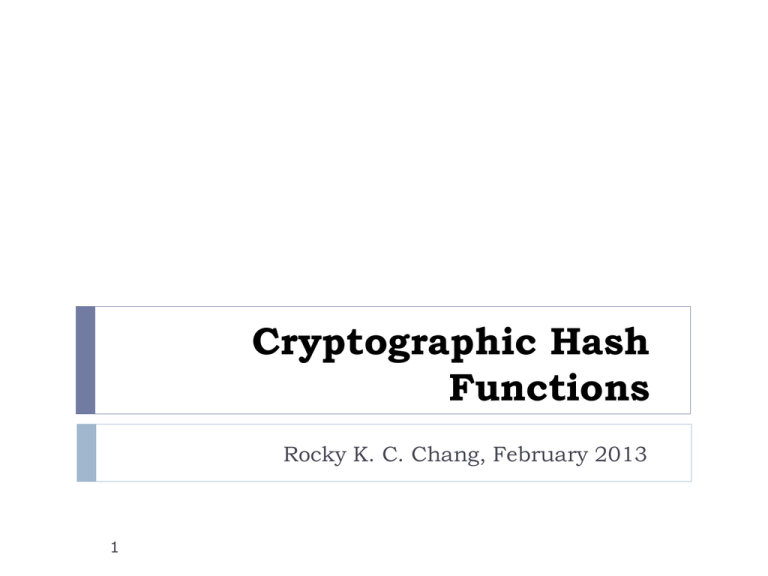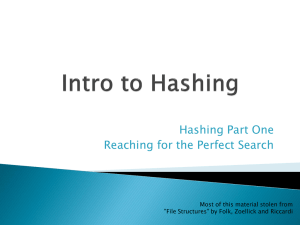Cryptographic hashing
advertisement

Cryptographic Hash
Functions
Rocky K. C. Chang, February 2013
1
This set of slides addresses
Secret key
functions
Secrecy
service
2
Public key
functions
Authentication
service
Hash
functions
Message
integrity service
Nonrepudiation
service
Outline
Cryptographic hash functions
Unkeyed and keyed hash functions
Security of cryptographic hash functions
Iterated hash functions
Two weaknesses
Message authentication codes
3
What does an MAC do?
MAC security
HMAC
Using MAC properly
Cryptographic hash functions
4
Hash functions
A hash function (or message digest function) takes an
arbitrarily long string of bits and produces a fixed-sized
result.
5
The hash result is also known as digest or fingerprint.
Cryptographic hash function vs. hashing used in data structures
and algorithms.
Cryptographic hash function vs. error detection codes, such as
checksum and CRC
For examples,
For a message m, compute x = h(m).
Assume that x is stored in a safe place, but m is not.
Whenever retrieving m, compute h(m).
If h(m)= x, one should be confident that m has not been altered.
Alice and Bob share a secret key K, and use hK() to protect the
integrity of their messages.
Assume that K is only known to Alice and Bob.
Alice (or Bob) computes x = hK(m) and sends (m, x) to Bob (or Alice).
At Bob’s (or Alice) side, he computes hK(m).
6
If hK(m) = x, (s)he should be confident that both m and x have not been
altered.
Many uses of cryptographic hash functions
Message authentication (or message integrity) and digital
signature
Map a variable-sized value to a fixed-size value.
Serve as a cryptographic pseudo-random generators to
generate several keys from a single shared secret.
Their one-way property isolates different parts of a
system.
7
A (keyed) hash family consists of
M: a set of possible messages
X: a finite set of possible message digests
K: the key space, a finite set of possible keys
For each KK, there is a hash function hK H. Each hK: M
X.
Moreover,
8
Usually assume that |M| ≥ 2|X|.
A pair (m, x) is valid under the key K if hK(m) = x.
|K| = 1 for unkeyed hash functions.
Security of a cryptographic hash function
The basic requirement for a cryptographic hash function is
that
The only efficient way to produce a valid pair (m, x) is to first choose
m, and then compute x = h(m).
As a counter example, consider a message: (m1, m2) with h(m1,
m2) = am1 + bm2 mod n, where m1, m2, a, b Zn, n>1.
Given h(m1, m2) and h(m’1, m’2), one can determine the value of h()
for other messages.
For a message (rm1+sm’1, rm2+sm’2), h(rm1+sm’1, rm2+sm’2) = r
h(m1, m2) + s h(m’1, m’2).
Security of a cryptographic hash function can be evaluated
based on the difficulty of solving three problems.
9
Problem 1: The preimage problem
The preimage problem:
Given a hash function h: M X and an element x X,
Find m M such that h(m) = x.
If the preimage problem can be solved, then (m, x) is a valid
pair.
A hash function for which the preimage problem cannot be
efficiently solved is said to be one-way or preimage resistant.
10
Problem 2: The second preimage
problem
The second preimage problem:
Given a hash function h: M X and an element m M,
Find an m’ M such that m’ m and h(m’) = h(m).
If the 2nd preimage problem can be solved, then (m’, h(m))
is a valid pair.
A hash function for which the 2nd preimage problem
cannot be efficiently solved is said to be second preimage
resistant.
11
Problem 3: The collision problem
The collision problem:
Given a hash function h: M X,
Find m, m’ M such that m’ m and h(m’) = h(m).
If (m, x) is a valid pair, and m, m’ is a solution to the
collision problem, then (m’, x) is also a valid pair.
A hash function for which the collision problem cannot
be efficiently solved is said to be collision resistant.
Which problem is the easiest to solve?
12
Solving the preimage problem
Consider the following algorithm to solve the preimage
problem.
1.
2.
3.
13
Choose a subset M0 M and |M0| = q.
For each m M0, if h(m) = x, return m.
Return “unsuccessful.”
Pr[success] = 1 – Pr[all q attempts are unsuccessful].
Assuming independent events, Pr[all q attempts are
unsuccessful] = Pr[an attempt is unsuccessful]q.
Let |X|=B and Pr[an attempt is unsuccessful] = 1–1/B.
Therefore, Pr[success] = 1–(1–1/B)q ≈ q/B if q is small
compared to B.
Solving the 2nd preimage problem
Consider the following algorithm to solve the 2nd
preimage problem.
1.
2.
3.
4.
Compute h(m).
Choose a subset M0 M\{m} and |M0| = q–1.
For each m’ M0, if h(m’) = h(m), return m’.
Return “unsuccessful.”
Pr[success]
14
= 1–(1–1/B)q–1 .
Solving the collision problem
Consider the following algorithm to solve the collision
problem.
1.
2.
3.
4.
Choose a subset M0 M and |M0| = q.
For each m M, evaluate h(m).
If h(m) = h(m’) for some m’ m, return m’, m.
Else, return “unsuccessful.”
To
15
conduct step 3, one can sort the values of h().
Solving the collision problem
Problem: what is the success probability of the algorithm
to solve the collision problem given q attempts?
Assume uniform probability and independence.
Pr[unsuccessful] = Pr[all the q values of h() are different]
= (B/B)((B–1)/B)((B–2)/B) … ((B–q+1)/B).
Pr[successful] = 1–Pr[unsuccessful] = 1–(B/B)((B–
1)/B)((B–2)/B) … ((B–q+1)/B).
Pr[successful] 1 – e-q(q-1)/2B for a sufficiently large B.
16
The birthday attack
Q: How many attempts are needed so that Pr[successful]
≥ p? (birthday problem if B = 365)
After performing more approximation for Pr[successful]
1 – e-q(q-1)/2B , we have
q (2B ln(1/(1- Pr[successful])))1/2.
For p = 0.5, q 1.17B.
17
Hashing just over B random elements of M yields a collision
probability of 0.5.
Different values of p will give different constant factors, but q is
still proportional to B.
For a n-bit hash function, a birthday attack (or square root
attack) needs 2n/2 random hashes.
Answer for the birthday problem?
Which problem is the easiest to solve?
Re-examining the 3 problems
If we can solve the 2nd preimage problem, we can also solve
the collision problem.
If we can solve the preimage problem, we can also solve the
collision problem.
Randomly choose an m M.
Use the solution to the 2nd preimage problem to find m’.
Return (m, m’).
Randomly choose an m M.
Compute h(m).
Use the solution to the preimage problem to find m’.
Return (m, m’).
Collision resistant => 2nd preimage resistant and collision
resistant => preimage resistant.
18
Iterated hash functions
Almost all hash functions put into practice are iterated
hash functions.
An iterated hash function h() usually consists of three
main steps:
h: M X, where X = {0, 1}p (i.e., n-bit hash function).
(1) Preprocessing
(2) Processing
(3) Output transformation
Require a compression function for step (2):
19
Compress : {0,1}n+t {0,1}n, t ≥ 1.
Iterated hash functions
Message m
(1) Preprocessing
IV = z0
y1
compress
z1
...
compress
zr-1
compress
zr
Optional g()
h(m)
20
y2
...
yr
(1) Preprocessing
Given an input string m, where |m| ≥ n + t + 1, construct
a string y, such that |y| 0 (mod t).
This step must ensure that the mapping my is one-toone.
Let y = y1 || y2 || … || yr, where |yi| = t, i = 1, 2, …, r.
t is the block size and r is the number of blocks.
Else, it is possible to find m ≠ m’ so that y = y’.
Then h(m) = h(m’), i.e., h() would not be collision-resistant.
Moreover, |y| = rt ≥ |m| because of the one-to-one
requirement on the mapping my.
A commonly used preprocessing step is to add padding: y
= m || pad(m).
21
(2) Processing and (3) output transformation
(2) Processing
Let IV be a public initial value of length n. Compute
zo IV
z1 compress(zo || y1)
z2 compress(z1 || y2)
…
zr compress(zr-1 || yr).
(3) Optional output transformation
22
Let g: {0,1}n {0,1}p be a public function. Without this
transformation, we have n = p.
Merkle–Damgård construction
The construction is based on the iterated hash function
construction with
The last block is padded with 0 and a binary string that
encodes the length of the original message (Merkle–Damgård
strengthening).
The compress function is collision-resistant.
Ralph Merkle and Ivan Damgård independently proved that the
hash function is collision resistant if the compress function is
collision-resistant.
This construction was used in the design of many popular
hash algorithms such as MD5 and SHA1.
23
Two main hash functions
Message Digest (MD5) and Secure Hashing Algorithm (SHA-1)
MD5
t = 512 bits and p = 128 bits (4 x 32-bit)
The compress function is made from an “encryption function” by the
Davies-Meyer scheme.
The hash output is a concatenation of the 4 output words.
MD5 makes four passes over each block of data.
SHA-1
24
t = 512 bits and p = 160 bits (5 x 32-bit)
The compress function is also made from an “encryption function” by
the Davies-Meyer scheme.
The hash output is a concatenation of the 5 output words.
SHA-1 makes five passes over each block of data.
Security of MD5 and SHA-1
If the compress function is collision resistant, then the
iterated hash function is also collision resistant.
Security of MD5
Security of SHA-1
The Compress function in MD5 is known to have collisions.
The 128-bit hash size is also insufficient.
SHA-1 was broken by a research team from Shandong University in
2005.
Collisions in the full SHA-1 in 269 hash operations, much less than the
brute-force attack of 280 operations.
SHA-2 (SHA-224, SHA-256, SHA-384, SHA-512)
SHA-3, originally known as Keccak which was the winner
of the NIST hash function competition in 2012.
25
Weakness 1: length extensions
Consider a message m is split into blocks m1, m2, …, mk
without padding and hashed to a value h(m).
Choose a message m’ that splits into the block m1, m2, …,
mk, mk+1 (the first k blocks are identical to m’s).
Therefore, h(m) is the intermediate hash value after k
blocks in the computation of h(m’).
Thus, h(m’) = Compress(h(m), mk+1).
Even with padding, one can show that a similar length
extension attack can be launched.
26
What is the problem?
The main problem is that there is no special processing at the
end of the hash function computation.
Consider that Alice sends a message to Bob and wants to
authenticate it by sending h(K||m), where K is a secret shared
by Alice and Bob.
Now an attacker can append text to m, and update the hash
value without knowing K.
27
Weakness 2: partial message collision
Suppose an attacker can get a system to authenticate a single
message only, e.g.,
Alice
Bob
rA
h(rA || K)
rB
h(rB || K)
How can the attacker use the hash value to send another
“authenticated” message to Bob?
28
Partial message collision
First, the attacker has to find 2 strings m and m’ that lead
to a collision when hashed by h(), i.e., the birthday attack.
Then he gets Bob to authenticate m, i.e., receiving h(m||K)
from Bob.
Since h() is computed iteratively,
29
Once there is a collision (h(m) = h(m’)) and
the rest of the hash inputs are the same (K),
the hash value stays the same too (h(m||K) = h(m’||K)).
Message authentication codes
30
Message authentication codes
An MAC is a construction that prevents tampering
(modify, replay) with messages.
Encryption does not prevent an attacker from manipulating
messages.
Like encryption, MACs use a secret key K known only to
both Alice and Bob.
31
Alice sends a message m to Bob with a MAC value MAC(K,m).
Bob checks that the MAC value of the message is equal to
MAC(K,m).
Security of MAC
Similar to hash functions, an ideal MAC(K,m) should be
computationally indistinguishable from a random mapping.
An attack on MAC is successful if
Given (m1,MAC(K,m1)), (m2,MAC(K,m2)), …, (mk,MAC(K,mk)),
An attacker is able to find a message m (not m1, m2, …,mk) together
with its valid MAC(K,m).
The success of the attack does not necessarily require a full
knowledge of K.
32
Generating the MAC
There are 2 main approaches to generating MACs.
(CBC-MAC) Use of CBC and the MAC is the last block of the
ciphertext.
(HMAC) Use keyed hash functions.
The CBC-MAC is generally considered secure if the underlying
cipher is secure.
33
A number of different collision attacks that limit its security level.
Avoid using the same key for encryption and authentication.
Keyed hash functions
Hash functions were not originally designed for message
authentication.
Authentication of what?
A message is sent from a certain source.
A message has not been modified after being sent.
A message is not an old message.
The main problem is how to encode a shared secret into
a hash function.
34
A few possibilities
The secret-prefix method: MAC(K,m) = h(K||m).
The secret-suffix method: MAC(K,m) = h(m||K).
Subject to the length extension attack
Subject to the partial message collision attack
The secret-prefix-suffix method: MAC(K,m) = h(K||m||K).
35
A 128-bit key can be recovered using 267 known text-MAC
pairs.
HMAC
HMAC computes h(K opad || h(K ipad || m)).
opad and ipad are specified constants, and they should have a
large Hamming distance from each other.
The message m is hashed only once and the output is hashed
again with the key.
HMAC uses hash function as a black-box.
h() can be any of the iterative hash functions, such as MD5 and
SHA-1.
The main idea is to “key” the initial states for a hash
function.
HMAC was chosen as the mandatory-to-implement
authentication transform for IPSec (RFC 2104).
36
Using MAC properly
What information should be authenticated?
Or, what part of a packet should be included in MAC(K,m)?
The Horton Principle: Authenticate what is being meant,
not what is being said.
37
An MAC only authenticates a string of bytes (what is being
said), but
Not necessary the interpretation of the message (what is
meant).
For example,
The authenticated message may include
A “message ID” that prevents replay attack,
The source and destination of the message,
Protocol field, etc.
In another case, Alice may use MAC to authenticate m = a
|| b || c, where a, b, and c are some data fields.
38
Additional (authenticated) information may be sent to Bob on
how to interpret these data fields, in terms of their lengths, for
example.
Summary
Examined the problems connected to the security of a cryptographic hash
function.
The birthday attack is a major attack on hash functions.
All the practical hash functions, such as MD5 and SHA-1, are based on
iterated hash functions which can be subject to
Length extension attacks and
partial message collision attacks
Message authentication is based on MAC computed on a message and a
shared secret.
The MAC’s security can be compromised for some keyed hash functions.
Authenticate what is being meant, not what is being said.
39
Acknowledgments
The notes are prepared mostly based on
40
D. Stinson, Cryptography:Theory and Practice, Chapman &
Hall/CRC, Second Edition, 2002.
N. Ferguson and B. Schneier, Practical Cryptography, Wiley, 2003.








